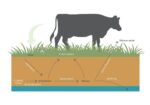Milk from NZ dairy cows: sustainable, nutrient-dense, tasty too
By Dr Tim Mackle Chief Executive, DairyNZ As Kiwi families and friends sit down at the table this summer and plan picnics at the beach, they can be confident the dairy products from our New Zealand cows are both highly sustainable and one of the best sources of human nutrition on the planet. When deciding what food to eat, I’m a firm believer people need accurate, science-based information grounded in the New Zealand context, and aimed at ensuring we know what’s healthy – and sustainable. To mark the holidays when most of us will be celebrating with delicious food, I’m plating up some of the wealth of evidence being offered independently by scientists that New Zealand cows’ milk is both highly sustainable and nutritious – and, of course, makes for some tasty tucker too. My intent is to help you with informed decision-making about what to eat that’s best for human health and wellbeing, as well as what’s best for the planet – and equip anyone wishing to get involved in conversation about food and the environment. New Zealand is already world-leading in sustainable nutrient-dense dairy products. As identified by the International Dairy Federation New Zealand Committee, if all dairy producers were as efficient as we are, more than half the global emissions from dairy production could be eliminated. The sustainability and nutritional value of the food we’re eating is on the minds of many people, an ongoing topic of conversation on social media feeds, and hitting the headlines in mainstream media. Among recent coverage are in depth articles in two notable New Zealand magazines – North & South (December 2019) and NZ Listener (October 5-11 2019). With due recognition of these publications, their writers and the food scientists they interviewed – and to avoid any risk of the more […]









